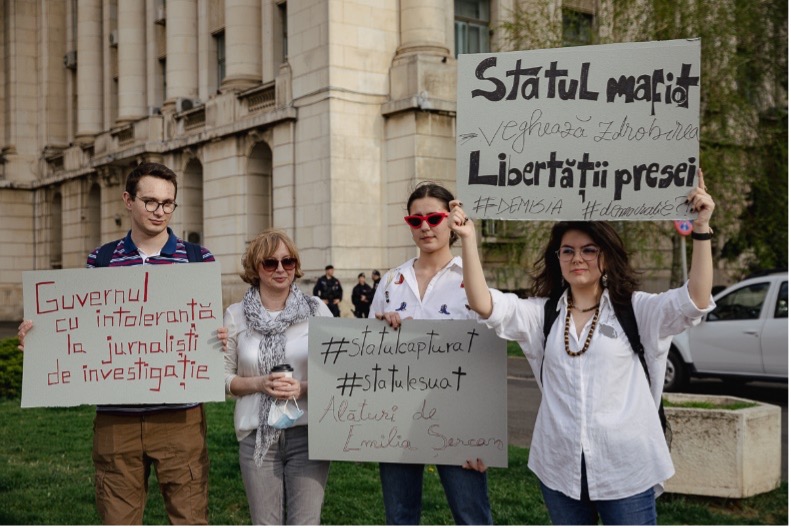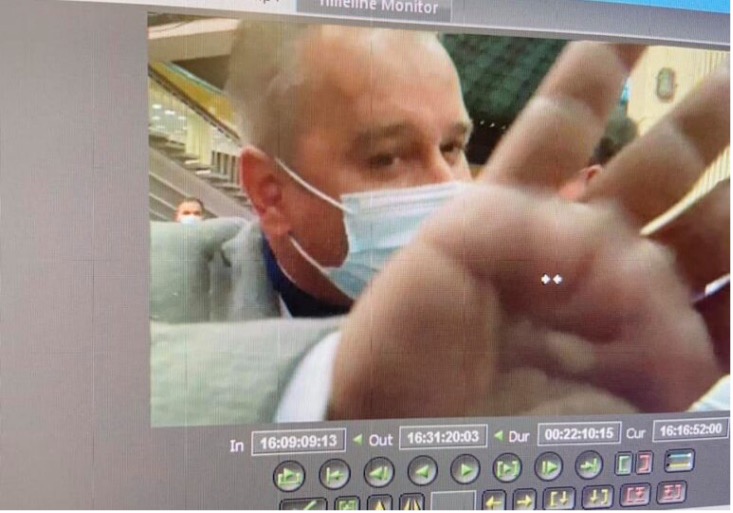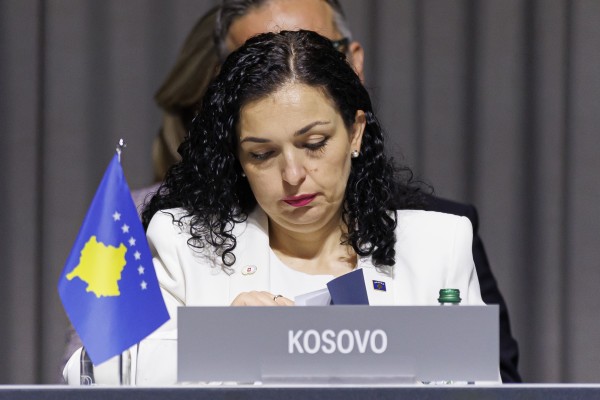This piece is published in collaboration with Libertatea as part of a content series on threats to independent media in Central Europe. Read more.
In a cultural context dominated by “violent traditionalism” against women, female journalists in Romania often become the target of harassment and threats. However, this is very seldom discussed in the public sphere, as gender-based violence against women in general, and women journalists in particular, remains a peripheric topic. Or as one media analyst says: Human dignity and women’s rights are secondary, not-so-important issues.
Emilia Şercan is one of Romania’s most well-known independent investigative journalists. She’s also one of the most harassed. On July 21 this year, she published a death threat that she had received three years ago, when she was investigating high-profile plagiarism cases in the Romanian Police Academy. Şercan publishes her investigations on the independent media platform Pressone.
The threat read: “We are sending this message in order to prevent what is about to come. Stop all the activities that you are currently pursuing if you don’t want the ordeal to follow. Do you want to end up like Elodia? We will cut off your hands and feet.”
She made the threat public the same day a Romanian court sentenced the two perpetrators to a suspended three-year prison term. The people behind the threat were two former heads of the Romanian Police Academy, Adrian Iacob and Mihail Marcoci.
It wasn’t the only time Șercan was subjected to threats and harassment. This year, the journalist was the victim of a kompromat operation, with the aim of discrediting her. This happened right after she had published an investigation showing that the current Romanian prime minister, Nicolae Ciuca, plagiarized parts of his PhD.
Irene Khan, the U.N. special rapporteur on freedom of opinion and expression, said last November that “while both male and female journalists are exposed to violence and threats to their safety in retaliation for their work, attacks on the women are gender-based and highly sexualized online and offline”.
The death threat
Reflecting on the death threat, Șercan recounts that in the beginning she didn’t take the gender perspective into account. The initial confusion and shock were too big.
“After a while I realized that if I hadn’t been a woman, I don’t know if there would have been a threat, and second, I don’t know if the nature of the threat would have been the same”, Șercan says.
The reference to Elodia in the death threat is quite suggestive, Șercan explains. “Elodia is a woman who had disappeared. The authorities concluded that she was killed, but there was no clear information about her disappearance”.
Șercan believes that the perpetrators were expecting to scare her and stop her. “[They think] If they tell me harsh things, I will back off. She’s a woman and she’ll be scared when she sees a message like that.”

On April 9, around 100 protesters gathered in front of Romania’s Interior Ministry to show their support for Emilia Șercan and ask for the resignation of the interior minister, Lucian Bode. Foto: Eli Driu
Inducing guilt as a harassment strategy
However, the gender perspective didn’t elude her when private photos of her were stolen.
Sercan described the whole kompromat operation in an article published in April this year.
On February 16, a stranger sent her a Facebook message that included five personal photos that Șercan’s former fiancé took of her around 20 years ago. They were taken in a restaurant or at home, in the bathroom, after the shower. She was shocked that an unknown person owns personal photos of her. The shock got even bigger when she discovered, on the same evening, that some of those pictures had been uploaded on adult websites.
The journalist understood that the photos had been stolen from one of her electronic devices and later uploaded online, as she had never sent them to anybody. She took a screenshot of that Facebook message.
The next morning she sent the screenshot on WhatsApp to a police officer who was already investigating two other threats the journalist had received some weeks before. Șercan then made a complaint to the Criminal Investigation Service and the screenshot was added to the criminal file as a piece of evidence.
”At the time I left the police station, that screenshot was only hosted in two places: on my personal phone and on the phone of the deputy police commissioner, to whom I had provided it as evidence”, writes Sercan.
40 minutes after leaving the police office, the screenshot, as well as the five stolen photos, were published on a website registered in Moldova. Later on, 74 websites published identical articles, with a link to the initial article. The journalist then understood that the screenshot was leaked from the police.
The Romanian police later tried to cover up the operation by claiming that the screenshot and the photos were first published on a website called patrianoastra.com on February 16, a day before Șercan made the complaint to the police. Independent investigations carried out by Bitdefender or the Swedish cyber security group Qurium showed that the police’s report was false. Patrianoastra.com was not the initial source. It only posted them on February 18. The initial source was a website from Moldova owned by a former Romanian MP, Cristian Rizea. He is in hiding in Moldova after receiving a four-year prison sentence in 2019 for influence peddling and money laundering.
“This time it was obvious. How do you compromise a woman more easily? You try to undermine her as a person by showing that she has morality problems”, Șercan says.
Șercan came to understand that the people behind this operation were trying to induce guilt and shame. “I was confused in the beginning. I didn’t know how to react to this”, the journalist recounts.
In this sense, inducing guilt can be a more toxic strategy than fear, and more effective as a harassment mechanism. It makes you doubt yourself, Șercan explains.
A conversation with an acquaintance helped her become aware of it. “This person told me: ‘They’ve managed to make you see yourself through the eyes of others, to see yourself as guilty. What is the guilt here? What is wrong with those pictures? Somebody stole them. It is clearly not your fault’.”
From that moment, her perspective completely changed.
She also realized that the police investigation into the leak of criminal case information was very slow and very sloppy. Șercan believes that they were counting on the fact that she wouldn’t talk publicly about the kompromat operation because of the shame. But she did.
“It was the best I could have done. It set me free”, the journalist says.
“The state authorities orchestrated a kompromat operation against me. Now they are trying to cover it up”, wrote Şercan.
A range of attacks
Emilia Șercan’s case goes beyond harassment, according to Ionuț Codreanu, a researcher and media analyst at the Romanian NGO ActiveWatch. “It is a coordinated operation to intimidate her and to publicly humiliate her.”
He explains that there have been several cases of attacks and harassment against Romanian female journalists in the last five years.
Three female journalists were grabbed, pushed, and prevented from filming at the National Political Party’s congress in September last year by politicians.
Investigative journalist Diana Oncioiu received a death threat in the summer of 2019, while she was investigating a case of sexual abuse in the Romanain Ortodox Church.
After being hit with tear gas at a protest in the summer of 2018, Romanian photojournalist Ioana Moldovan was told by a police officer: “What did you want me to do, fuck you? Stupid fuck, who made you come here and take photos?”

A Romanian politician assaulted a female journalist at the PNL congress in September 2021. Source: Facebook/Iulia Garbacea
“Politicians would like all journalists to disappear, regardless of their gender. However, the nature of aggression is different when it comes to female journalists. It is almost something visceral. [It’s as though they are saying] How does a woman dare ask me questions?”, Codreanu says.
Male journalists are threatened as well, but the methods are slightly different. They are interrogated by enforcement agencies or become victims of SLAPPs, the media analyst adds.
‘I was more easily seen as a target’
Investigative journalist Diana Oncioiu, who writes for the Dela0 independent media platform, says that she has often been called “aggressive” while doing her job. “I am not aggressive. I am just asking questions. They find it more offensive when the questions are asked by a woman.”
She has experienced online violence in several instances. “I hope you are going to be raped by gypsies so you stop defending them”, a man commented on social media while Oncioiu was working on a story about a ghetto in Bucharest. “Maybe a rock will fall onto your head when you are walking on the street”, a woman wrote on the journalist’s Facebook page.
Nearly three-quarters (73 percent) of journalists identifying as women experienced some form of online violence, according to the results of a UNESCO report published last year. 25 percent of the 901 survey respondents received threats of physical violence, including death threats.
In the summer of 2019, while working on an investigation about sexual abuse in the Romanian Ortodox Church as part of a journalistic collective called Să fie Lumină (Let there be light), Diana Oncioiu received a death threat via a phone call from an unknown number.
“We will break your head if you continue documenting the Church’s private business,” threatened a man. “We know where you live. We know what car you drive”, he added. A police investigation later revealed that he was a former theology student.
Even though the phone call was intended to be a warning to the whole team, the female journalist in the collective was the one directly targeted. There are two main reasons, says Oncioiu.
“While the guys (her male colleagues) were in charge of the judicial process, I was coordinating the part related to the victims. So I was more exposed. The other reason has to do with the society in which we live. It is considered easier to threaten a woman. I was more easily seen as a target.”
However, Oncioiu had no hesitation to talk publicly about the threat. “It was very clear for me that I had to talk. It is not ok to threaten a journalist doing their job. We were just cautious about how much we could share. But I wasn’t afraid and I wanted to make it very clear: we will continue our work even if you threaten me.”
No talking about this
“Any citizen in this country, but especially women, counts up to a million before deciding to talk publicly about an abuse”, media analyst Ionuț Codreanu says.
”This happens because of how society is designed. The premise is that you are lying, trying to destroy the reputation of absolutely honorable people. It is a mixture of violent traditionalism, where you keep things under the rug, and politics. And politics is very violent”, he adds.
Romanian journalist Ioana Ene Dogioiu recently revealed in an article that a former justice minister tried to rape her in his office almost 30 years ago. She didn’t talk to anyone because she thought she wouldn’t be believed. Some people asked her why she recounted all this after so many years.
“Every time we have the opportunity to talk about violence, intimidation, about the reduction of women to the status of untermensch, the effect is the opposite, like a boomerang. The first question is ‘what did she do? She surely did something’”, Codreanu adds.
The media analyst remembers how Liviu Dragnea, one of Romania’s most powerful political leaders before going to jail in 2019, used to address all female journalists in press conferences with a diminishing and dismissive “young lady” (domnișoară). “I asked myself why didn’t all journalists leave those conferences? Why didn’t they protect their colleagues?”.
Codreanu believes that it also has to do with how Romanian journalists are educated to understand their mission.
“Journalists are taught from university that getting the news is the most important thing and they need to be prepared to put up with anything. Like in a war zone. Discussions about human dignity, reputation, how you relate to journalism become posh, marginal”, Codreanu concludes.
This piece is part of a content series on threats to independent media in Central Europe in collaboration with leading independent media in the region. Any viewpoints expressed in these articles do not necessarily represent the views of IPI. Read more.



